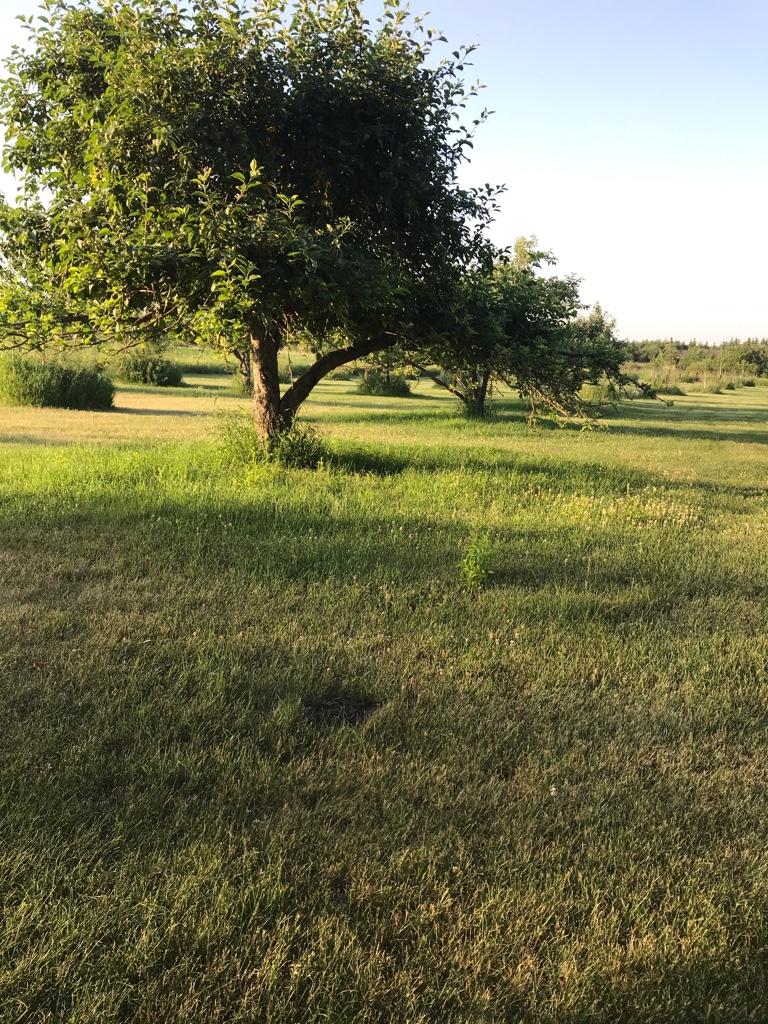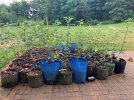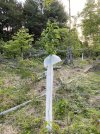You are using an out of date browser. It may not display this or other websites correctly.
You should upgrade or use an alternative browser.
You should upgrade or use an alternative browser.
Dolgo seedlings/ rootstock
- Thread starter sandbur
- Start date
BuckSnort
5 year old buck +
White Birch Farm
5 year old buck +
Here's an update on the Dolgo seedling rootstock I purchased from Blue Hill this year.
I bench grafted 70 of them in mid-March, by cleft grafting them. By around mid-April, some of the rootstock had new growth a couple inches long, and since they weren't getting any light and the leaves were very yellow, I moved them all outside. We had a couple of 27 degree nights after that, but it did not seem to phase the growth on the rootstock.
Out of the 70 I grafted, there is just one where the rootstock and scion never woke up. One other rootstock has something wrong with it. The leaves on that rootstock and scion are reminiscent of what a glyphosate damaged tree's leaves look like. I'm not saying it is glyphosate damage, that's just what it looks like. It could be genetics. The scions on two others died after initially displaying swelling buds, but the rootstock is doing well, so I can bud them in August. Overall, 94% of my grafts are looking good right now.
None of the rootstock have red leaves.
I bench grafted 70 of them in mid-March, by cleft grafting them. By around mid-April, some of the rootstock had new growth a couple inches long, and since they weren't getting any light and the leaves were very yellow, I moved them all outside. We had a couple of 27 degree nights after that, but it did not seem to phase the growth on the rootstock.
Out of the 70 I grafted, there is just one where the rootstock and scion never woke up. One other rootstock has something wrong with it. The leaves on that rootstock and scion are reminiscent of what a glyphosate damaged tree's leaves look like. I'm not saying it is glyphosate damage, that's just what it looks like. It could be genetics. The scions on two others died after initially displaying swelling buds, but the rootstock is doing well, so I can bud them in August. Overall, 94% of my grafts are looking good right now.
None of the rootstock have red leaves.
sandbur
5 year old buck +
This is another one from BH that wasView attachment 34808 planted last spring.
You might be getting a double leader on that one. Can you pinch off one of them?
Sent from my iPhone using Tapatalk
Up until about a week ago, we had a really bad drought. I had planted bulk orders of grafted whips on standard and ungrafted Dolgo seedlings from Blue Hill this spring when the frost went out. I didn't have time to water any of the trees since planting them. The Dolgo seedlings are the clear winners as far as survival rate.
One of my 20 year old Dolgo seedling trees that I top worked this spring is sending up dozens of suckers from its roots within 3' of the base again this year. That is a tree that produces root suckers that grow their own roots as well and I nip them off at the parent root when the frost goes out and immediately plant them elsewhere. I've been mounding those for years. I've posted the information about that tree before.
The big surprise this year is that I had a Dolgo seedling from Lawyer Nursery that I planted 20 years ago that turned into a double trunk tree and I cut it back to a single trunk two or three years ago, and its roots are sending up suckers way out yonder all the way along its roots similar to what a Black Locust tree does. I will be fencing those root suckers this fall and see if I can stool those as well. They would be clones of a crabapple tree that drops its fruit during the peak of the rut. I had read years ago that apples trees growing in sand have roots that go out three times as far as the tree's crown. My observations seem to be consistent with at least that distance ratio.
The big surprise this year is that I had a Dolgo seedling from Lawyer Nursery that I planted 20 years ago that turned into a double trunk tree and I cut it back to a single trunk two or three years ago, and its roots are sending up suckers way out yonder all the way along its roots similar to what a Black Locust tree does. I will be fencing those root suckers this fall and see if I can stool those as well. They would be clones of a crabapple tree that drops its fruit during the peak of the rut. I had read years ago that apples trees growing in sand have roots that go out three times as far as the tree's crown. My observations seem to be consistent with at least that distance ratio.
sandbur
5 year old buck +
One of my 20 year old Dolgo seedling trees that I top worked this spring is sending up dozens of suckers from its roots within 3' of the base again this year. That is a tree that produces root suckers that grow their own roots as well and I nip them off at the parent root when the frost goes out and immediately plant them elsewhere. I've been mounding those for years. I've posted the information about that tree before.
The big surprise this year is that I had a Dolgo seedling from Lawyer Nursery that I planted 20 years ago that turned into a double trunk tree and I cut it back to a single trunk two or three years ago, and its roots are sending up suckers way out yonder all the way along its roots similar to what a Black Locust tree does. I will be fencing those root suckers this fall and see if I can stool those as well. They would be clones of a crabapple tree that drops its fruit during the peak of the rut. I had read years ago that apples trees growing in sand have roots that go out three times as far as the tree's crown. My observations seem to be consistent with at least that distance ratio.

I posted this picture somewhere, maybe on another thread. This chestnut crab has been in the ground over 30 years. It throws rootsuckers up to 7 paces from the tree and I have dug many of them. This spring, I topworked three of them that are down by the pond to Big Dog and Buckman crab. Maybe I can get a picture later.
My farmstead and wild plum rootstock also throw. Rootsuckers up to 8 paces from the tree. I have a hard time getting them to survive when I dig them.
These are on lighter soil( top of the hill).
My hybrid poplar on light soil is throwing rootsuckers, while a sister tree that is 50 yards away on heavy soil is not. This makes me wonder if the lighter souls create shallower roots to grab every drop of moisture.
Or, there is less heavy sod on lighter soils, and daylight or some other factor causes hormone changes in the roots.
Sent from my iPhone using Tapatalk
sandbur
5 year old buck +

I posted this picture somewhere, maybe on another thread. This chestnut crab has been in the ground over 30 years. It throws rootsuckers up to 7 paces from the tree and I have dug many of them. This spring, I topworked three of them that are down by the pond to Big Dog and Buckman crab. Maybe I can get a picture later.
My farmstead and wild plum rootstock also throw. Rootsuckers up to 8 paces from the tree. I have a hard time getting them to survive when I dig them.
These are on lighter soil( top of the hill).
My hybrid poplar on light soil is throwing rootsuckers, while a sister tree that is 50 yards away on heavy soil is not. This makes me wonder if the lighter souls create shallower roots to grab every drop of moisture.
Or, there is less heavy sod on lighter soils, and daylight or some other factor causes hormone changes in the roots.
Sent from my iPhone using Tapatalk
You can see where I dug one rootsucker in the foreground. The rootsuckers throw a half inch crab.
Sent from my iPhone using Tapatalk
Just some more info...
I have grown whips on standard, B118, M111, and Dolgo seedling in fabric pots. The roots of the first three I listed air pruned before they reached the fabric. The Dolgo seedlings did not air pruned as easily. Their roots grew into the seams of the fabric pots and took a bit of effort to remove at fall planting time, but not too much effort. They also typically had a higher root-to-shoot ratio than the others.
I have grown whips on standard, B118, M111, and Dolgo seedling in fabric pots. The roots of the first three I listed air pruned before they reached the fabric. The Dolgo seedlings did not air pruned as easily. Their roots grew into the seams of the fabric pots and took a bit of effort to remove at fall planting time, but not too much effort. They also typically had a higher root-to-shoot ratio than the others.
Here's a photo of how this year's bench grafts on Blue Hill's Dolgo seedling rootstock are doing for me. (The tip of the tape measure is set to 3' above the level of the mix in the pots, to provide some scale reference.) The scion varieties were Liberty, Enterprise, Florina, GoldRush, Galarina, February Dropper, Ide's of March, and Kerr. The success rate was 67 out of 70, using cleft grafts for all. No compatibility issues observed so far.


Chainsaw
5 year old buck +
Your plants are off to a good start Poor Sand. Mine are Planted in the ground and are shorter than yours but were kept cool later. I have not grown them in pots; what advantages/ disadvantages have you found by growing your grafts in pots versus directly in the ground? Thanks.
Chainsaw: I'm thinking/guessing that with your question you mean the advantage over growing them in a bed where I could water them just the same as I can in pots. The big advantage for me is ease of coordinating my fall planting crew helpers. I have all the posts and enclosures in place before fall dormant planting time. Early in the morning of the day when my helpers will arrive, I set each pot right next to where I want the tree planted and consistent with my orchard maps. When my helpers arrive, they can move very quickly from one tree planting site to the next without needing to do any tree fetching or deliberating whether they have the right tree for the right planting spot.
Ben: I used B200 Bulk Growers Nursery Mix from Gerten's in Inver Grove Heights, Minnesota, again this year. It consists of 54% composted pine bark fines, 18% sphagnum peat moss, 16% rice hulls, 12% masonry sand, and lots of time release fertilizer. It is the mix the nursery uses to grow potted trees fast. They have a front end loader with a one yard bucket and dump it into the bed of my pickup truck. One yard is about right for filling 70 three trade gallon pots.
The mix is rather light and airy. I have a sprinkler system set up that I run for an hour every other day if we don't get rain.
The mix is rather light and airy. I have a sprinkler system set up that I run for an hour every other day if we don't get rain.
BuckSnort
5 year old buck +
Wondering how your success / experience has been with fall planting? Rough timeframe? I’m planning to move toward fall planting this year down in Central WI. Spring planting just doesn’t work well with my job so I’ve got to do something different.Chainsaw: I'm thinking/guessing that with your question you mean the advantage over growing them in a bed where I could water them just the same as I can in pots. The big advantage for me is ease of coordinating my fall planting crew helpers. I have all the posts and enclosures in place before fall dormant planting time. Early in the morning of the day when my helpers will arrive, I set each pot right next to where I want the tree planted and consistent with my orchard maps. When my helpers arrive, they can move very quickly from one tree planting site to the next without needing to do any tree fetching or deliberating whether they have the right tree for the right planting spot.
BuckSnort: My success with end of October planting of potted apple trees has been rather good. The main problem I have had is with grasshoppers moving in during the following July and stripping the bark off those trees if I don't get out there to spray the trunks of with insecticide in time.Wondering how your success / experience has been with fall planting? Rough timeframe? I’m planning to move toward fall planting this year down in Central WI. Spring planting just doesn’t work well with my job so I’ve got to do something different.
BuckSnort
5 year old buck +
Well I guess now I know the plan.BuckSnort: My success with end of October planting of potted apple trees has been rather good. The main problem I have had is with grasshoppers moving in during the following July and stripping the bark off those trees if I don't get out there to spray the trunks of with insecticide in time.
Late Oct / Early Nov:
1. Shoot nice buck in the morning.
2. Plant apple trees in the afternoon.
3. Protect trees from every insect & disease known to man and wait patiently.
Chainsaw
5 year old buck +
I too plan to try fall planting. Due to the relative warm water in nearby Lake Ontario in the fall there is a fairly large window here where our ground is not frozen but trees have lost their leaves.Well I guess now I know the plan.
Late Oct / Early Nov:
1. Shoot nice buck in the morning.
2. Plant apple trees in the afternoon.
3. Protect trees from every insect & disease known to man and wait patiently.


